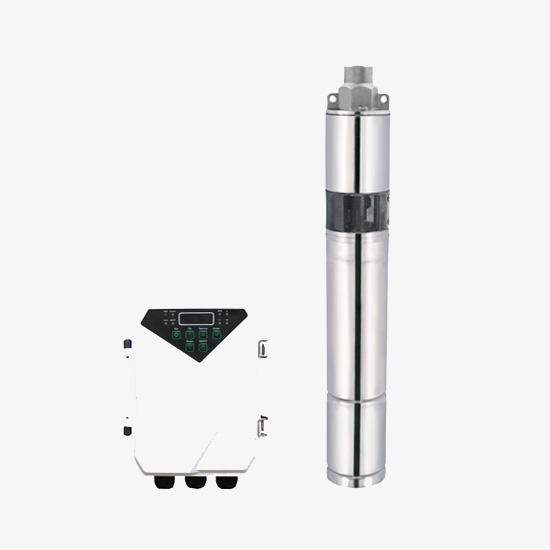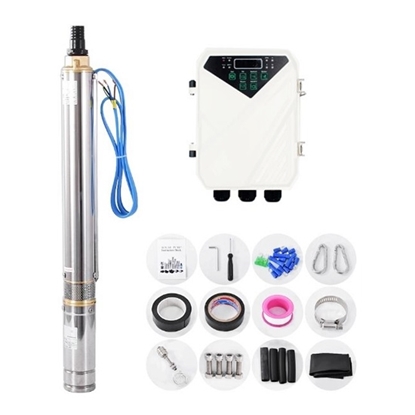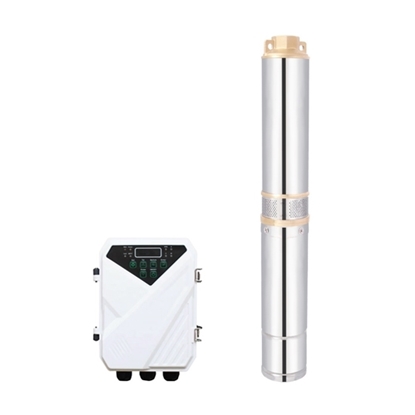Well Pump
1300W Submersible/Deep Water Well Pump, 110VDC
2 hp (1500W) Submersible/Deep Water Well Pump, 110VDC
A water well pump is a pump that is used in extracting water from a water well. The deep well pump has the advantages of compact structure, small size, light weight, convenient installation, use and maintenance, safe and reliable transportation, and energy saving.
ATO.com online store offers well pump of wide range power from 80W to 1500W for selection, working voltage DC 12V/ 24V/ 48V/ 72V/ 110V. The deep well pump has a special DC controller with LED which can display power, voltage, current and speed values in real time. DC controller drives the submersible water pump pumping water from deep wells/ pond/ rivers/ lakes, and injecting water to tanks/pools or irrigation/ fountain systems.
The water pumping system brings new resource-saving and environment-friendly solutions for agricultural, irrigation, desert management, urban water feature and home use. Buy a deep well water pump for your needs now!
What is Well Pump?
A submersible pump is a device which has a hermetically sealed motor close-coupled to the pump body. The whole assembly is submerged in the fluid to be pumped. The main advantage of this type of pump is that it prevents pump cavitation, a problem associated with a high elevation difference between the pump and the fluid surface. Submersible pumps push fluid to the surface, rather than jet pumps, which create a vacuum and rely upon atmospheric pressure. Submersibles use pressurized fluid from the surface to drive a hydraulic motor downhole, rather than an electric motor, and are used in heavy oil applications with heated water as the motive fluid.
How does Water Well Pump Work?
The well pump pushes the water from your well into a storage tank, which will store it until you need it. When the motor is in operation, it will draw water into the pump, which then pushes it to the surface into a pressure tank.
Pumping water into this pressure tank will cause the tank’s air pressure to increase until it reaches a specific preset level, ranging from 40 to 60 psi. When you turn a faucet on in your house, the force of the lessening air pressure in the tank pushes water through your plumbing. Once the air pressure drops down to around 40 psi, this will turn the pump back on again, and the pump will immediately start to drive more water into the storage tank.
Water Well Pump Troubleshooting
- No water or little flow after startup
After starting, the pump rotates, but there is no water or the flow rate is small. It should be stopped immediately for inspection. If the time is a little longer, the rubber bearing may be burned and the pump may vibrate. The main reasons are: (1) The pump body is not submerged enough in the water or the water level in the well drops too much, and the water inlet is exposed to the water surface and air is sucked in. (2) The mud sand and debris in the water block the water inlet pipe, impeller or water guide casing flow channel, and the debris in the pump or well must be cleaned before installing the pump. (3) The impeller is loose, the transmission shaft or the pump shaft is broken, which causes the impeller to not rotate. This type of failure is caused by improper assembly of the pump body or excessive adjustment of the axial clearance. (4) The water outlet pipe is broken and tripped, resulting in a large amount of water leakage, resulting in reduced water output or no water. - Difficulty or inability to start
If the switch is turned on, the fuse blows immediately or the motor only hums and does not rotate or the rotation does not reach the rated speed. All are startup failures. - The operating rate of the deep well pump increases
If it is found that the reading of the ammeter or power meter on the switchboard suddenly increases, it means that the power of the deep well pump shaft increases and the motor is overloaded. The cause should be immediately identified and dealt with, and the overload time of the motor should be shortened as much as possible to avoid burning the motor. Reasons for the increase in the power of the pump shaft: (1) The axial clearance of the impeller is too small, which causes mechanical friction between the impeller and the water guide shell, and the clearance should be adjusted by stopping the machine. (2) The packing is too tight, the gland nut should be loosened properly; (3) The motor bearing is damaged, the bearing should be replaced. (4) The water contains a large amount of mud and sand, and the running parts are blocked by mud and sand, so the pump should be removed to clean the well. - Strong vibration occurs when the deep well pump is running
(1) Vibration at start-up may be due to the lack of pre-lubricating water or insufficient water. It should be stopped immediately to add pre-lubricating water to avoid dry friction and cause the rubber bearing to hold the shaft after high temperature. (2) The axial clearance of the drive shaft is too small, which causes mechanical friction and collision between the impeller and the water guide casing, causing vibration, and should be stopped immediately for inspection. (3) The drive shaft is bent or the rubber bearing is excessively worn, and the supporting function is lost, causing the drive shaft to swing. The drive shaft should be checked and straightened. (4) The well pipe is not vertical, and the transmission shaft and the water pipe are squeezed and bent to cause vibration. The deep well pump should be removed to straighten the well pipe.



